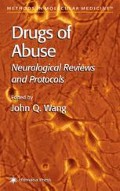Abstract
Degeneration of dopaminergic neurons in the substantia nigra is a hallmark of Parkinson’s disease (PD). However, despite decades of research, the cause of PD and the underlying mechanism of action responsible for the progressive degeneration of nigral dopaminergic neurons remain poorly understood (1). The creation of rodent and primate models for PD has provided a valuable tool in the study of the pathogenetic progression of the disease (2). On the other hand, primary neural cell cultures have become extremely valuable in the delineation of the molecular and cellular mechanisms of neuronal death. In light of the increasing appreciation of the role brain immune cells play in the neurodegenerative process (3), establishment of enriched primary cultures of neurons, microglia, and astroglia enables the dissection of the complex in vivo system in an in vitro setting. The utility of these cultures has helped gain critical information on the role each cell type plays and the potential factors produced by individual cell types that contribute to the neurodegeneration (4–10). Here we describe our laboratory’s routinely used procedures for establishing primary mixed mesencephalic neuron-glia, mixed glia, neuron-enriched, microglia-enriched, and astroglia-enriched cultures.
Access this chapter
Tax calculation will be finalised at checkout
Purchases are for personal use only
References
Olanow, C. W. and Tatton, W. G. (1999) Etiology and pathogenesis of Parkinson’s disease. Annu. Rev. Neurosci. 22, 123–144.
Langston, J. W., Langston, E. B., and Irwin, I. (1984) MPTP-induced parkinsonism in human and non-human primates—clinical and experimental aspects. Acta Neurol. Scand. Suppl. J. Immunol. 100, 49–54.
Liberatore, G. T., Jackson-Lewis, V., Vukosavic, S., et al. (1999) Inducible nitric oxide synthase stimulates dopaminergic neurodegeneration in the MPTP model of Parkinson disease. Nat. Med. 5, 1403–1409.
Kong, L. Y., Maderdrut, J. L., Jeohn, G. H., and Hong, J. S. (1999) Reduction of lipopolysaccharide-induced neurotoxicity in mixed cortical neuron/glia cultures by femtomolar concentrations of pituitary adenylate cyclase-activating polypeptide. Neuroscience 91, 493–500.
Jeohn, G. H., Wilson, B., Wetsel, W. C., and Hong, J. S. (2000) The indolocarbazole Go6976 protects neurons from lipopolysaccharide/interferon-gamma-induced cytotoxicity in murine neuron/glia co-cultures. Brain Res. Mol. Brain Res. 79, 32–44.
Chang, R. C., Chen, W., Hudson, P., Wilson, B., Han, D. S., and Hong, J. S. (2001) Neurons reduce glial responses to lipopolysaccharide (LPS) and prevent injury of microglial cells from over-activation by LPS. J. Neurochem. 76, 1042–1049.
Kim, W. G., Mohney, R. P., Wilson, B., Jeohn, G. H., Liu, B., and Hong, J. S. (2000) Regional difference in susceptibility to lipopolysaccharide-induced neurotoxicity in the rat brain: role of microglia. J. Neurosci. 20, 6309–6316.
Liu, B., Du, L., and Hong, J. S. (2000) Naloxone protects rat dopaminergic neurons against inflammatory damage through inhibition of microglia activation and superoxide generation. J. Pharmacol. Exp. Ther. 293, 607–617.
Qin, L., Liu, Y. X., Cooper, C. L., Liu, B., and Hong, J. S. (2001) The role of microglia in beta-amyloid (1–42) toxicity to cortical and mesencephalic neurons. Abstr. Soc. Neurosci. 27, 548.13.
Gao, H. M., Hong, J. S., Zhang, W. Q., and Liu, B. (2002) Distinct role for microglia in rotenone-induced degeneration of dopaminergic neurons. J. Neurosci. 22, 782–790.
Paxinos G., Tork, I., Tecott, L. H., and Valentino, K. L. (1991) Atlas of the Developing Rat Brain. Academic Press, San Diego.
Liu, B., Gao, H. M., Wang, J.-Y., Jeohn, G.-H., Cooper, C. L., and Hong, J. S. (2002) Role of nitric oxide in inflammation-mediated neurodegeneration. Ann. NY Acad. Sci. 962, 318–331.
Author information
Authors and Affiliations
Editor information
Editors and Affiliations
Rights and permissions
Copyright information
© 2003 Humana Press Inc., Totowa, NJ
About this protocol
Cite this protocol
Liu, B., Hong, JS. (2003). Primary Rat Mesencephalic Neuron-Glia, Neuron-Enriched, Microglia-Enriched, and Astroglia-Enriched Cultures. In: Wang, J.Q. (eds) Drugs of Abuse. Methods In Molecular Medicine™, vol 79. Humana Press. https://doi.org/10.1385/1-59259-358-5:387
Download citation
DOI: https://doi.org/10.1385/1-59259-358-5:387
Publisher Name: Humana Press
Print ISBN: 978-1-58829-057-1
Online ISBN: 978-1-59259-358-3
eBook Packages: Springer Protocols

